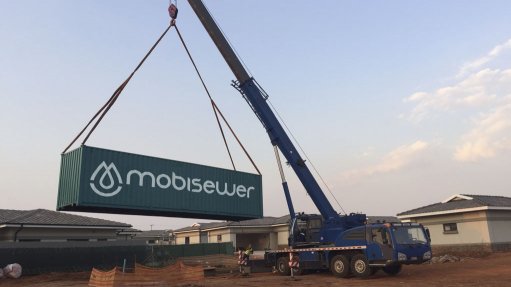
FIRST INSTALLATION The MobiSewer incoporates all sewage treatment processes in one container
Water recycling solutions provider Biobox is installing its first locally manufactured MobiSewer sewage treatment system unit at a retirement estate in Benoni, Gauteng. The recycled water will be used for water features and irrigation throughout the estate.
The MobiSewer is a rotating biological contactor (RBC) which is suited, particularly, to Africa, where sites are often remote and underserved by technical expertise. Unlike other sewage treatment systems available today, MobiSewer does not use blowers or aerators, which makes it more reliable, with less breakdowns of costly electrical components, and requiring minimal power for its operation.
“The MobiSewer’s power demand is so low that it can be powered from a small solar energy installation, allowing for it to be installed anywhere imaginable,” says Biobox MD David Light.
The MobiSewer incorporates all the sewage treatment plant processes, including primary settlement, anaerobic digestion, anoxic and aerobic treatment, final settlement, polishing and disinfection into a single 12-m-high cube container. The system can be configured as a standalone unit or, with suitable flow diversion in parallel unit processes to cater for larger demands.
He notes that Biobox started the development of the MobiSewer in 2010 and was undertaken by local and international wastewater engineers. After design iterations, the system was approved for piloting in 2015. Following further testing and optimisation in 2016, it was production-ready last month, which resulted in the installation of the system at the retirement estate.
“There has been a high level of interest and demand for the MobiSewer. We have local and international orders lined up for golf and residential estates, retail and office spaces, construction camps, university accommodations and wineries,” he points out.
With this growing interest, Light notes that the MobiSewer’s research and development work is ongoing to increase its treatment capacity and improve final effluent quality.
Currently, Biobox has patent-pending innovations on the MobiSewer such as a flow control system that improves process performance by buffering peak flows, and a tertiary polishing filter that uses Biorock media to further enhance final water quality.
How It Works
Most sewage treatment systems are based on a combination of processes, usually including an aerobic process, which adds oxygen to the sewage to encourage micro-organisms/bacteria to feed on pollutants in the water.
Conventional activated sludge systems use energy-intensive pumps, blowers and aerators, whereas the RBC process of the MobiSewer enables bacteria to receive air naturally from the atmosphere to support bacterial growth.
This is accomplished by slow-rotating media discs located on a central shaft. In the RBC process, 40% of the discs remain submerged in the wastewater. As the discs rotate, it creates turbulence in the wastewater and, subsequently, aeration.
Because of this continuous process, bacteria accumulate on the discs and consume pollutants in the wastewater.
The MobiSewer was primarily developed for domestic wastewater treatment in communities ranging from 250 to 5 000 people and for businesses with wastewater treatment needs of between 10 000 to one- million litres a day.
Industry Overview
Light avers that rapid technological developments enable wastewater treatment plants to implement low-cost monitoring, improved process control and ultimately minimise pollution of already stressed natural water resources in South Africa.
“In our experience, water users want to flush and forget. Together with our industry, we need to continue developing smarter solutions that offer hygienic waterborne sanitation to the masses while being robust and simple in operation, and provide water recycling for use in nonpotable applications such as water for irrigation or industrial processes.
“While the cost of desalination as an alternative water source remains prohibitive, we simply cannot afford to waste water by flushing it down the drain or polluting freshwater sources,” he notes.
With the advent of smart technology, it is possible to measure and inform users on their water behaviour. An example of this is integrating rainwater harvesting solutions into households, shopping centres, hotels or office buildings to automatically switch between rainwater and municipal water, depending on the need for use.
“A smart system can display current water reserves, but likewise forecast water availability based on demand or use patterns. This technology can also detect problems with one water source and switch to another accordingly, or reduce the pressure to minimise leaks and send a notification to a smartphone,” Light concludes.